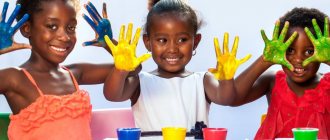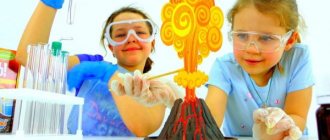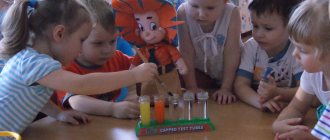Cognitive and creative project in the preparatory group of the kindergarten “Steps to School”
Conversation “Profession teacher”.
TASKS:
1) arouse children’s interest in the world around them, form realistic ideas about people’s work;
2) expand knowledge and ideas about professions; 3) enrich vocabulary, develop coherent speech: teach children to give complete answers to questions, preparing them to retell the text; 4) develop the ability to coherently and consistently retell the text according to plan; 5) activate children’s attention and memory, develop logical thinking. Progress of the conversation:
Educator: Dear guys!
Do you know what a profession is? A profession is work to which a person devotes his life. Let's remember together what professions there are. (Children's answers.) That's right! Teacher, doctor, educator, driver, librarian, salesman, accountant... There are a lot of professions! We will talk to you about some of the most common ones. Every morning, the adult members of your family go to work. Tell us what their professions are. What do your family and friends do? What is your mother's job? And dad? Would you like to have your dad's or mom's profession? Why? The task is not easy - to become a master, To embellish the face of the Earth. It is much more difficult to convey your skills and knowledge to others. For centuries, craftsmen have given their experience to Other generations as a gift, And people have always gratefully gone to mentors and masters. The Teacher can be picky and strict, And often “gets you”, But every Teacher is a little bit of God, Who creates you. Teacher.
Ask your mom and dad if they remember their first teacher? They'll probably say yes and even say her name. In the first grades, the same teacher teaches schoolchildren the basics of various sciences, transfers to them his knowledge and skills. This is an elementary school teacher. After the third or fourth grade, you will be taught by several teachers at once. Teachers of Russian and foreign languages, mathematics, biology, physics, chemistry, history, geography, physical education, music, labor. To become a teacher, you need to graduate from a pedagogical school or pedagogical institute. A good teacher not only knows a lot himself. He also knows how to properly pass on his knowledge to children. Knows how to make sure that the student is not distracted, so that he is interested in the lesson. And, of course, he loves and understands his students. The work of a teacher is very difficult and responsible. Because it is the teacher who gives the first knowledge to future cosmonauts, scientists, captains, metallurgists, writers, trainers, weavers, divers and people of other professions.
Summary of the educational activity “Back to school soon!”
Target:
Forming in children the position of a “future schoolchild”
Objectives:
1. Organize the research activities of preschoolers according to a certain algorithm (setting a goal, specifying the content of the research, activating ways to obtain information, obtaining information).
2. Promote the development of dialogical speech for the exchange of information. 3. To form the child’s personal qualities: observation, curiosity, mental operations. 4. Arouse children’s interest and positive attitude towards learning; 5. Develop sociability, friendliness, respect for each other and adults. Materials:
illustrations, symbol cards denoting qualities, blanks for making a collage, simple pencils, numbers from 1 to 10.
Preliminary work:
Conversation “Soon to school”, conducting a role-playing game “School”, listening to an audio recording of “Songs about School”, looking at illustrations depicting a school, classes, school supplies.
GCD move:
- Guys, please tell me, who are the schoolchildren? (These are children who go to school). — What qualities should a student have? (He must be able to communicate, search for information independently, be attentive, well-mannered, active, healthy). Symbol cards are placed on the easel. — I suggest you conduct research and find out who the schoolchildren are. Do you want to know? (Yes) The teacher offers to look at the illustrations. — Pay attention to the illustrations. At the end of our research, we will find out what qualities a schoolchild needs and create a collage: “Who are schoolchildren.” — In order to begin our research, we need to answer the question “What does our speech consist of?” "(from sentences, words, syllables, sounds) - What sounds are there? (Sounds are vowels and consonants, hard and soft, deaf and voiced). — How do letters differ from sounds? (We pronounce and hear sounds, and we write letters). - Tell me, children, why do you need to learn to write? (To convey information) - What do you think is needed to write beautifully and correctly? (Listen carefully to the teacher, train your fingers) - To make your fingers flexible, dexterous and skillful, let's play with them. Finger gymnastics: (using a pencil) I roll the pencil in my hands and twirl it between my fingers. I will certainly teach every finger to be obedient. In order to complete the next task, please work together in pairs. 1. Connecting letters at the points Ш, К, О, Л, А, 2. Composing the word “SCHOOL” from the resulting letters 3. Sound analysis of the word “SCHOOL” 4. Coming up with a sentence with the word “school” 5. Coming up with words with a given sound Conclusion: We have completed the first research task. Please tell me what the first quality is necessary for successful study at school. (Be able to communicate, learn to speak beautifully, be independent, active). Children attach the corresponding picture to the collage. -Now imagine guests come to you. You greeted them. Please tell me what the word “Hello” means? (Health, wishing others health). -What do you think should be done to maintain and strengthen your health? (do exercises, walk, train, go to physical education classes) Assignment for couples: 1. Conduct a physical education session 2. Complete the exercise according to the diagram. 3. Show proper posture when writing. 4. Carry out eye exercises. -You completed this task without difficulty. Conclusion: What is the next quality necessary for success in school? To be healthy, strong, you need to strengthen and maintain your health. Children attach pictures to the easel. So, we have the next research task. - Guys, the numbers are in conflict. Make peace between them. Get things in order. Logical thinking task. 1. “Find the pattern and complete the drawing.” 2. Solution to the problem Four magpies flew to class. One in forty didn't learn the lesson. How many diligently studied forty? -Name the condition of the problem, question, solution, answer. 3. Composition of the number 12. 4. Drawing by cells. Conclusion: You need to be able to work according to instructions, be able to highlight the main thing, be smart. Next task: - we need to find out what rules need to be followed at school. From what sources do you think we can find out the information we are interested in? (from the Internet, from a book, ask parents, older children, watch a TV show, etc.) Find information yourself using a book. Each named rule is indicated by a pictogram and posted on the board or attached to a poster. - Speak one at a time, listen to each other - Do not interrupt the one who is speaking - Do not use physical force against others - Do not insult anyone, do not tease anyone, etc. Conclusion: We have learned the third quality that a schoolchild needs. Name it, please. Children: You need to follow the rules of behavior, be well-mannered, and cultured. — What do you think a student needs to study at school? (Briefcase, pencil case, notebooks, books, diary, etc.). Children work in subgroups (girls, boys, and collect a briefcase). Educator: Well done! You put everything you need for studying in your briefcase. Guys, you completed all the tasks, you are very smart students.



